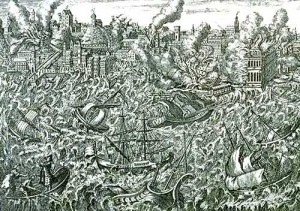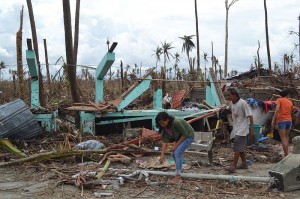By Mark J. Spalding, President, The Ocean Foundation
History majors such as me are often asked how we wound up working on ocean governance and conservation. Sitting here in the ancient city of Lisbon, it is easy to answer that. After all, this is the capital of a country with centuries of maritime exploration heritage, rich in marine resources, and determined to look to the sea to support its future as well. It is also a city that knows better than most how environmental events can change its course—an awareness that has been thrown into stark relief in the central Philippines nearly 8,000 miles away.
Many of us spent part of our elementary school years learning about the European Age of Discovery, including Portugal’s Vasco da Gama’s departure to India in 1497, which was the first step in what would later be known as the Portuguese Empire. The 16th century came to be known as Lisbon’s Golden Age until 1580, when the country lost its independence to Spanish rule for six decades. As with 14th century Lisbon, the city was also known for another phenomenon: earthquakes. Major earthquakes were recorded throughout the 1500’s, including in 1597 when it is said that three streets disappeared.

A later earthquake, one that changed the course of Lisbon’s history, and is the event that holds the closest parallel to the post-typhoon tragedy that continues to unfold in the Philippines. Modern seismologists estimate that the 1755 Lisbon earthquake measured an 8.9 or more on the Richter Scale. On the morning of November 1, when many were gathered in churches for All Saints Day services, three powerful tremors struck. The power of the quake opened up wide fissures in city streets, and caused people to rush to the perceived safety of the docks. There, as the story goes, they watched as the water rolled back, leaving hundreds of boats stranded, their cargos scattered, and fish and other animals flopping around. And then, the first wave of the tsunami rolled up the Tagus River and sank the remaining boats and washed up through the lowest reaches of the city. It was followed by two more waves. By sunset, tens of thousands of people were dead. Across the city, fires were raging, the city center was in ruins, most of the libraries, universities, and churches were damaged or destroyed, and the maritime economy was decimated. Even the royal palace was destroyed. The course of Lisbon’s future had changed, and so too, it would turn out, the health of the economies of the rest of Europe.

The 1755 earthquake-born tsunamis devastated ports in the Azores, Ireland, England, and Morocco. Some records indicate that Greenland and Martinique each recorded smaller tsunamis from the quake. In Lisbon itself, the effort to rebuild began within a month—driven by King Joseph I and Prime Minister Sebastiao de Carvalho e Melo, the Marquis de Pombal. The Marquis also sent a questionnaire to all the parishes of the country asking them to describe when they felt the shocks, how strongly they felt them, how many peopled died, what kind of damage had been done, and whether the sea had fallen first or risen first. Those surveys represent a critical historical record that informs our understanding of the seismic activity of the region, even as it gave contemporary decisionmakers some way of assessing the effects of the earthquake and the needed response. Today, Lisbon reflects their vision of a city of open squares and wide boulevards. It also holds some of the earliest buildings to be constructed to withstand seismic shock—reflecting perhaps, a city’s early adaptation to the forces of nature it could not control.

We are learning more each day about the true extent of damage to Leyte and rest of the central Philippines from the devastating typhoon that hit late last month. Coming on the heels of a severe earthquake in the region, the effects of the storm further dismantled critical infrastructure and natural systems. It is not clear that there was any way to be truly prepared for a storm of this strength and magnitude, or the devastation from its unprecedented storm surge, except perhaps to have adequate capacity to move relief efforts quickly and efficiently into the damaged region. In addition to the tragic loss of thousands of human lives, there is significant loss of infrastructure for the human communities that depend on the sea for their livelihoods. As for natural systems, we know from experience that the healthier those systems are before a storm, the more quickly they will become productive again.
So what can we do to help the Philippines recover? As many have done, we can and should give to short term relief efforts to help the devastated regional government establish basic services and address basic needs for food, water, shelter, and medical care. We can be grateful that the US government and the US Navy has the capacity to support relief efforts in diverse ways, as the Philippines offered its help after such events as Hurricane Katrina in 2005. And as these basic systems begin to be reestablished, we can support efforts to rebuild in the best way possible.
For example, Leyte Island was home to one of the most extensive geothermal energy-generating systems in the world—exporting electric power to many other parts of the 7000 islands that make up the Philippines—and reducing the nation’s climate footprint and dependence on imported fuels. That infrastructure should be repaired quickly, and where possible, hardened against future storms, or redesigned for quick recovery from inundation, just as the Marquis did in rebuilding Lisbon. Leyte can and should continue to be a leader in this regard.
Another recent report from the Philippines estimated that 100,000 fishermen lost their boats and other gear. Docks, warehouses, and other storage facilities were among the most vulnerable to the heavy winds and storm surge. Ocean-dependent communities that remain more intact still lack electricity to support refrigeration or fuel for their boats.
Some of the debris from the storm was swept into coastal waters when the storm surge receded. The extent of damage to life-supporting ocean systems remains unknown and may never be fully known, but assessing where debris should be removed, assuring the health of seafood in the wake of the deluge of pollutants from land, and beginning to rebuild the artisanal fishing infrastructure are all important. In addition, there may need to be some consideration given as to how to help assure short-term local food security in the event of another devastating storm, earthquake, or other disaster.

So as these hard hit Filipino communities begin to clean up and re-establish themselves, making the decisions about where to rebuild and how, and as they assess their complex dependence on the sea to support their economies—through activities such as tourism, recreation, and fishing—and decide how to proceed, we can offer our own expertise. Across the broader ocean conservation community, based on other recent experiences with unprecedented storms, whether they were high in the mountains or pounding the coasts, there are those who can contribute to the security and sustainability of the islands’ future, especially in the smaller coastal communities. And we can take lessons from the 18th century Portuguese leadership’s determination to help the communities frame their own vision. Rebuilding the Philippines with this past in mind, but with an eye to the future, is the primary goal.







